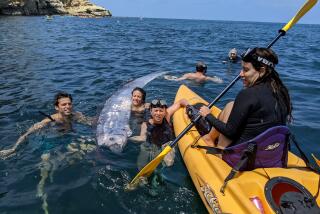Rare Wahoo Catch Might Be a Record
- Share via
Keith Winter was having a good enough time catching small dorado on a recent trip to Loreto.
He certainly never figured on coming home as the possible all-tackle record holder for wahoo.
But then the lure of fishing is that the unexpected can happen at any moment. And how unexpected can it get? A 157-pound wahoo landed where wahoo seldom roam.
Wahoo are rarely caught north of La Paz in the Sea of Cortez, and Loreto is 200 miles north of the Baja California Sur capital. Captain Loreto Veliz told Winter that he had only heard of three caught off Loreto in the past seven years.
But there is a catch, as far as the world record is concerned. The scale at the Oasis hotel, where the fish was weighed, was not certified and must be checked for accuracy by an official with the weights and measures department before the catch qualifies. The current all-tackle record is a 155.8-pound wahoo caught off the Bahamas in 1990.
“I weighed myself on the scale and it’s pretty darned close, within a pound or so,” Winter said, adding that he might still qualify for a line-class record.
He caught his fish--one of three seen swimming beneath his boat--on 40-pound test, for which there is no category. But the record on 50-pound line is a 140.10-pound fish.
But record or no record, Winter has a heck of a lot of wahoo to deal with.
“What am I doing with it?” he said, when asked. “We’ve been eating it; it’s really good.”
*
One can’t count on catching wahoo in Loreto, but it’s shaping up as an outstanding summer season for dorado. Most people are catching limits and the fish are averaging about 30 pounds, five pounds heavier than last year’s average, according to John Mestrin at Blue Water Tours in Seal Beach.
Sailfish and striped marlin have also been caught daily, he added.
*
Skippers of San Diego’s long-range vessels are encountering immense schools of tuna off the Baja coast, but landing operators are still waiting for the popular game fish to move within range of the overnight fleet.
Most of the fish are being found well south of the border and are reachable only on multi-day trips. Some schools have inched their way north, but for the most part have remained beyond 100 miles. Anglers still have to spend two nights at sea--and buy a higher-priced ticket--to have a good chance at catching them.
And even then, it’s hit and miss. The American Angler returned to port recently with a decent catch: 55 bluefin tuna and 85 yellowtail. But the Morning Star reported only six bluefin and 25 yellowfin.
*
Laura Taylor of Phoenix recently learned how formidable a foe a swordfish can be. Having hooked a broadbill estimated at 400-450 pounds on a Gaviota boat off Cabo San Lucas, she battled the fish for seven hours. But she was hardly rewarded for her efforts: The fish shook the hook “within a stroke of the gaff,” said Larry Edwards of Cortez Yacht Charters, the Lemon Grove representative for the fleet.
*
California hunters were involved in 15 hunting accidents in 1995, but there were no reported fatalities for the fourth year in a row, the Department of Fish and Game announced.
Deputy Chief Jack Edwards of the agency’s wildlife protection branch said more than half the accidents were vision-related, meaning the shooter did not see the victim, and that if more hunters wore blaze-orange clothing the number of accidents would probably drop. Most of the rest of the accidents, Edwards said, were self-inflicted, caused by carelessness.
*
Protecting man’s best friend from rattlesnakes is the theme of Saturday’s snake-avoidance clinic being offered--at a charge of $50 a dog--by the San Gabriel Valley chapter of Quail Unlimited.
The program, at Gameland Kennels in Norco, is geared toward but not limited to sporting breeds. Professional dog trainer Patrick Callahan will use de-fanged snakes and shock collars to teach dogs how to avoid the deadly vipers while romping through fields. Details: (818) 287-5060.
More to Read
Sign up for The Wild
We’ll help you find the best places to hike, bike and run, as well as the perfect silent spots for meditation and yoga.
You may occasionally receive promotional content from the Los Angeles Times.






